- Homepage
- >
- Industry
- >
- Applications with ion beams
- >
- IRRADIATION OF ELECTRONIC COMPONENTS
- FACILITIES
- IRRADIATION OF ELECTRONIC COMPONENTS
- IRRADIATION OF POLYMERIC MEMBRANES
- RADIATION BIOLOGY
- IRRADIATION OF MATERIALS
- ACCESS CONDITIOPNS & FINANCIAL CHARGES
- RADNEXT TNA
- CONTACT
IRRADIATION OF ELECTRONIC COMPONENTS
CAVE G4
Link for Transnational Access by RADNEXT project :
https://radnext.web.cern.ch/transnational-access/
https://irradiation-facilities.web.cern.ch/radnext.php

Equipment for irradiation of electronic components and systems: sample holder, possibilities, beams in terms of LET and range.
The GANIL is also a facility for the testing of electronic devices under heavy ions radiation, in a wide range of energy. SEE testing is possible with ions as Kr, Xe, Pb … in a wide LET range (16 to 96 MeV.cm²/mg).
| Ion | Energy (MeV/u) |
LET MIN (MeV.cm2/mg) |
Range (μm) |
LET MAX (MeV.cm2/mg) |
Range (μm) |
| 36Ar | 27 | 5,4 | 445 | 9,9 | 113 |
| 86Kr | 60 | 11,0 | 1223 | 42,1 | 27 |
| 129Xe | 50 | 26,5 | 685 | 64,3 | 35 |
| 208Pb | 29 | 72,7 | 258 | 97,6 | 64 |
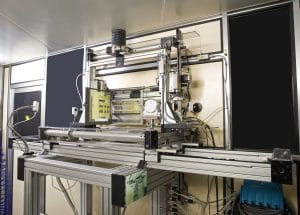 |
With the aim of irradiating electronic components and systems, the cave G4 is equipped with a sample holder. The irradiation occurs in the air; a stainless steel window (10 µm) separates the vacuum from the air. |
The electronic cards are fixed on the sample holder, and can be easily moved in the three directions (x, y and z) so that the target component receives the beam. The conception of the device allows to change the components quickly and surely.
You can download here the specifications of the sample holder.
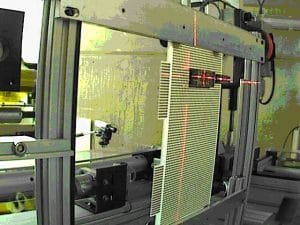 |
A red laser system indicates the center of the beam. A tilt possibility is also furnished (0 to 90°).
The LET calculation can be made with TRIM, taking into account the 10 µm of the stainless steel window and the air distance. |
For a given ion beam, a LET adjustment is possible by:
- introducing a thin foil of aluminum (25..1000 µm); a motorized device allows up to five different LETs
- adjusting the air distance between the component and the window (53..200 mm)
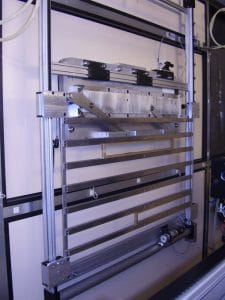
Some samples can be done on demand (please contact us).
D1 cave with 2 beamlines:
ME-IRASME (Medium Energy) and HE-IRABAT (High Energy)
The cave D1, managed by CIRIL, receives ion beams accelerated by CSS1 cyclotron and by CSS2 cyclotron. The accelerated ion species are from Carbon to Uranium.
For irradiation of components, two beam lines are available in D1:
- High Energy experiment at the energy of CSS2 exit in the range 24-95MeV/A corresponding to the maximum available at GANIL facility. The end station is the IRABAT chamber. When scheduled, these experiments are pilot of the facility and stripped beams are used.
- Medium Energy experiment at the energy of CSS1 exit in the range 4-13MeV/A. The end station is the IRASME chamber. When scheduled, these experiments could be pilot of the facility or working as parasitic beams of HE experiment; and always stripped beams are used.
For both lines irradiation conditions available are:
- continuous measurement of the ion flux, irradiation at high flux (105 to 109 ions/(cm².s)) or at low flux (below 104-105 ions/(cm².s)) for single event experiment
- scanning or not of the beam over surface up to around 16cm²
- irradiation under vacuum or under controlled atmosphere (non explosive gas, from few mBar up to 1Bar)
- on-site chambers and measurement devices are opened to users and special mechanic engineering dedicated the particular needs can be developed.
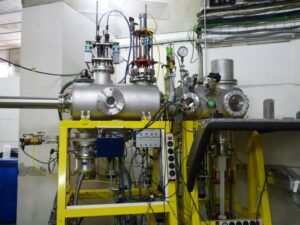 HE end station (IRABAT)
HE end station (IRABAT)
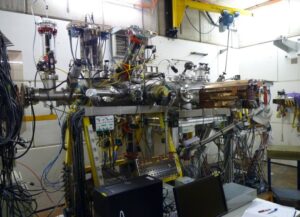 ME end station (IRASME)
ME end station (IRASME)
| HE* |
Ion | Energy (MeV/u) |
LET MIN (MeV.cm2/mg) |
Range (μm) |
| 36Ar | 95 | 2 | 4200 | |
| 86Kr | 60 | 10,5 | 1310 | |
| 129Xe | 50 | 25,7 | 721 | |
| 208Pb | 29 | 65 | 333 |
| ME* |
Ion | Energy (MeV/u) |
LET MIN (MeV.cm2/mg) |
Range (μm) |
| 36Ar | 13,7 | 8 | 182 | |
| 86Kr | 9,2 | 32,3 | 97 | |
| 129Xe | 7,7 | 63,2 | 73 | |
| 208Pb | 5 | 98 | 59 |
*calculations done in Silicon target as example.
For more details, please contact us.
